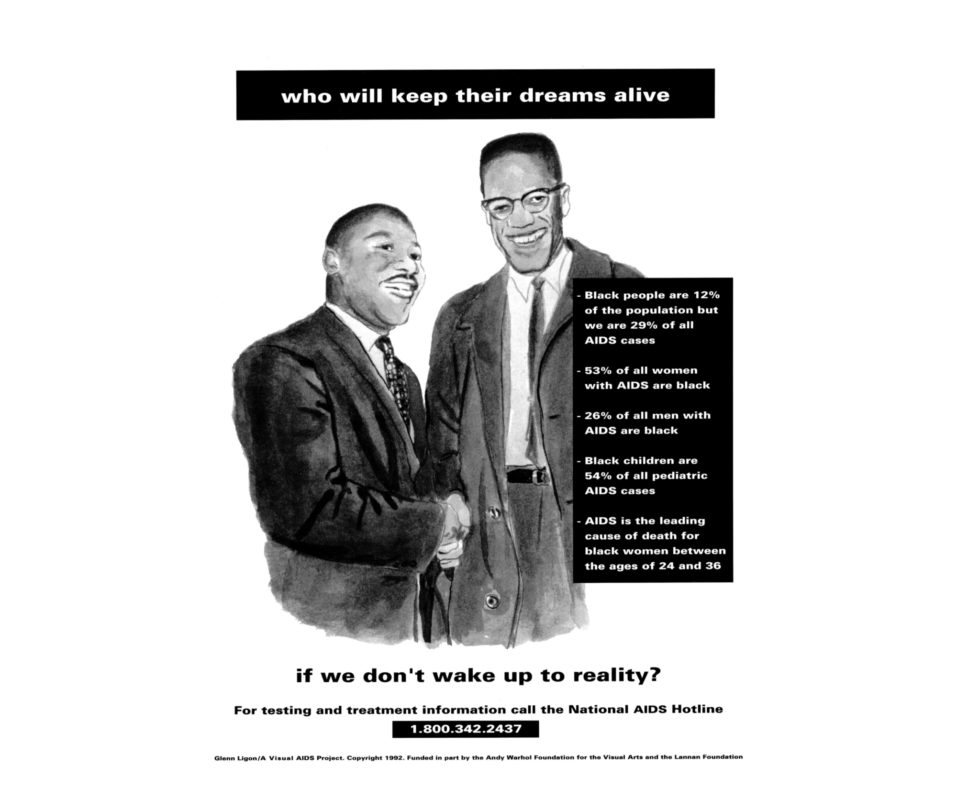Visual AIDS discusses the significant impact of the Tacoma Action Collective’s #StopErasingBlackPeople die-in protest at the Art AIDS America exhibition in 2015 at the Tacoma Art Museum and its intervention against the widespread whitewashing of HIV/AIDS cultural narratives.
Tacoma Action Collective & #StopErasingBlackPeople:
Direct action & interventions into institutions matter.
On December 17, 2015, the Tacoma Action Collective, a Black-led partnership of community organizers working in grassroots action and education in Washington State, disrupted the exhibition Art AIDS America at the Tacoma Art Museum with a die-in protest calling for the urgent need to #StopErasingBlackPeople (video here). Art AIDS America, the first large-scale traveling museum exhibition to consider the effects of HIV/AIDS on artistic practice in the United States, framed itself as a “groundbreaking” exhibition exploring the “whole spectrum of artistic responses to AIDS,” yet only five of the over one hundred artists included in the initial iteration of the exhibition at the Tacoma Art Museum were Black. Given the disproportionate impact of HIV/AIDS on Black communities, this erasure is particularly stark.
The Tacoma Action Collective’s #StopErasingBlackPeople disruption significantly shifted conversations towards diverse artmaking practices that more accurately represent and reflect the realities of the ongoing HIV/AIDS crisis; this shift against the otherwise rampant whitewashing of HIV/AIDS cultural narratives was fought for by the Tacoma Action Collective. Their 2015 die-in was in direct dialogue with the histories of direct action that re-shaped politics by challenging and changing dominant narratives of HIV/AIDS care and creativity throughout the ongoing HIV/AIDS epidemic. Black voices being centered in Visual AIDS’ Day With(out) Art 2017 similarly speaks to the Tacoma Action Collective’s efforts.
In New York City, the staff of Visual AIDS became deeply engaged in dialogue around the problematic representational politics of Art AIDS America, brought to the fore by the Tacoma Action Collective’s intervention. These conversations about the widespread whitewashing of HIV/AIDS cultural narratives coincided with the development of ALTERNATE ENDINGS, RADICAL BEGINNINGS, Visual AIDS’ Day With(out) Art 2017 project prioritizing Black narratives within the ongoing AIDS epidemic.To curate a Day With(out) Art centering Black voices, Visual AIDS understood the importance of involving a curatorial team deeply committed to both art of the African diasporas and the intersections of race, gender, sexuality and HIV/AIDS politics. In the summer of 2016, Visual AIDS invited Erin Christovale, co-curator of Black Radical Imagination, and Vivian Crockett, scholar and independent curator to curate Day With(out) Art 2017 (full bios here). Over 16+ months, the curator’s particular perspectives and engagements inspired a wide-ranging video program and publication (curatorial statement here), featuring seven newly commissioned short videos from artists Mykki Blanco, Cheryl Dunye & Ellen Spiro, Tourmaline, Thomas Allen Harris, Kia LaBeija, Tiona Nekkia McClodden and Brontez Purnell. We thank Erin Christovale and Vivian Crockett for their thoughtful and rigorous curation of Day With(out) Art 2017, and the incredible artists for the time, resources and creativity they have contributed to the project. Their dedication to developing new, ambitious works went far beyond what we ever imagined. Visual AIDS and the Day With(out) Art curators have also engaged the Tacoma Action Collective in recent months, inviting the Tacoma Action Collective to curate the December 2017 Visual AIDS web gallery and commissioning an essay titled “#StopErasingBlackPeople - Historical Lands” for the ALTERNATE ENDINGS, RADICAL BEGINNINGS publication, also published online here.
A central context for Day With(out) Art 2017 is the disproportionate impact of HIV/AIDS on the Black community in our present moment: While overall HIV transmission rates have generally declined across the nation and new preventative treatments have come into relatively widespread use, these developments and measures have had limited impact among Black communities. Decades into our fight against the HIV/AIDS epidemic, institutionalized racism, stigma, and other contributing factors still result in significant health disparities in the Black community. It is alarming to note that in the 25 years that have passed since Glenn Ligon produced his 1992 broadside for Visual AIDS (reproduced above to illustrate this post), these disparities have become more acute: in 2016, African Americans represented 44% of all new HIV diagnoses in the United States. Infection rates and statistics are often quoted in ways that further stigmatize populations made at risk, but action is seldom taken towards systemic change. Given this pressing urgency, Visual AIDS challenged ourselves to feature a range of stories that consider the lives of those reflected within these statistics.
At Visual AIDS, as with Day With(out) Art 2017, we continue to consider who is commissioned, whose voices are centered, whose concerns are raised, and more. We are committed to moving forward responsively, as part of our longstanding mission to utilize art to fight AIDS by provoking dialogue, supporting HIV+ artists and preserving a legacy, because AIDS is not over. The Visual AIDS Artist+ Registry, the largest database of works by artists with HIV/AIDS, open to all HIV+ artists, provides a unique resource in this regard as a visual record of a wide range of self-identified HIV+ artists and estates.
As Erin Christovale and Vivian Crockett conclude their Day With(out) Art 2017 curatorial statement, “We are asserting that these artists have been doing this work and that these histories have existed, whether or not they are recognized. ALTERNATE ENDINGS, RADICAL BEGINNINGS is a reclamation and affirmation of what has always been here.” The title itself points to renewed possibilities: ALTERNATE ENDINGS as a way to alter and edit historical reckonings and RADICAL BEGINNINGS as a way forward from these corrective understandings. We hope Day With(out) Art 2017 provides a platform for continuing these conversations while initiating necessary new dialogues into the future.
~Alex Fialho, Programs Director, on behalf of Visual AIDS
Further reference: Race, Gender and Identity in Art AIDS America: A Conversation with Kia LaBeija and Sur Rodney (Sur)

